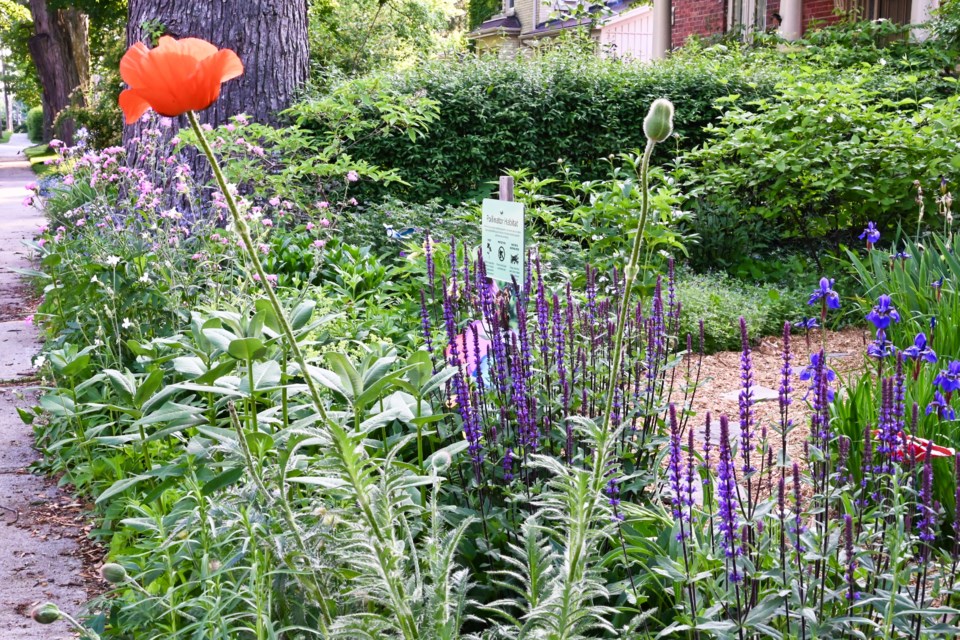They have been popping up all over the area and may already be in your neighbourhood.
Pollinator gardens are gardens created for the purpose of attracting pollinators like birds, bees, beetles, butterflies and more.
While more scruffy-looking than traditional gardens, their appearance plays a big role in providing food and shelter for these creatures.
"There's a wealth of things happening in your garden, you just have to be looking," said Nigel Raine, a professor in the school of environmental sciences at the University of Guelph, who also has a pollinator garden of his own.
“There are a lot of spaces where we are managing their habitat that aren’t farmland, or provincial parks, or natural areas,” said Raine, “So thinking about how we can support pollinators in urban areas or suburban areas is an important thing.”
If the buzz about pollinator gardens has made you consider starting your own, here are some tips from Raine:
Preparing your pollinator garden
Before breaking ground, Raine suggests residents think carefully about what they want to put into their pollinator garden and drafting up a plan.
“One of the other things to consider when designing a pollinator garden is what are you trying to attract and when,” said Raine, “Ideally, if you’re trying to be as most positive pollinator as possible, you want to think about things that flower at different times during the season.”
For example, he said if you’re trying to attract wild bees with your garden, different species will be active in the spring versus the fall.
What you can plant in your pollinator garden also depends on its size, soil and the amount of sunlight available. Raine recommends prepping the soil prior to planting to help ensure the ground has enough nutrients.
Finally, when starting a pollinator garden, Raine explains you may experience pushback if you line in a neighbourhood maintaining a certain aesthetic. If there is push back, Raine suggests putting up a sign indicating that it is a pollinator garden.
“You may have to have some conversations around what you want to achieve,” said Raine.
Choosing plants for your pollinator garden
It may seem like all flowers make good pollinators but that isn’t always true, said Raine.
“They may have multiple flower heads, or very, very dense petals...so the bees or other pollinators may not actually be attracted to the flowers or may be able to get in to access the pollen or nectar they’re trying to gather,” said Raine.
Besides flowers, Pollination Guelph has a list of other plants for your pollinator garden, including vegetables, fruits, herbs, flower trees and native plants.
“Picking plants that are native is a really good idea, both because that’s what the pollinators are expecting to find.”
One reference online residents can turn to is the City of Guelph pollinator garden guide, outlining some native plants that are good in different types of gardens here.
While native plants are good, Raine suggests keeping an eye out on plants specific pollinators gravitate toward in your neighbourhood.
“They’re pretty smart," he said about pollinators, "They won’t go to flowers that they can’t get any rewards from.”
“So if you see them visiting, that’s a pretty good sign.”
Maintaining your pollinator garden
Once you have planned and selected plants for your pollinator garden, residents will need to keep an inch of topsoil around newly planted plants moist by watering them once a week.
“It takes a little bit of time for them to branch out from the pots and create their root networks effectively,” said Raine.
Even with a plan, Raine mentions some plants may need to be moved around in order to thrive.“You may find that when you plant a few plants, some of them don’t do as well as you thought you would,” he said.
Despite our best efforts, sometimes plants in a pollinator garden can die. When this happens, Raine explains it’s important to learn from the plants that don’t survive.
“Don’t be afraid to change things up just because you thought that was right, it may not be quite right,” he said, “And the plants will tell you as well, when they’re doing well, you’ll see them grow quickly and they will flower well.”
When the leaves start to come down in the fall, try to resist the urge to clean them off your lawn.
“That's where some of these pollinators and other beneficial insects will be finding places for them to survive the winter,” he said about leaves and other organic waste materials, “Butterflies and some bee species will be nesting in the winter in piles of leaves.”
Pollinator gardens for small spaces
If you live in an apartment or only have a garden box to work with, you can still make your own pollinator garden.
“The less space you have the fewer plants you can plant, but it doesn’t stop you from attracting pollinators, ” said Raine about smaller gardens, which require more attention and water.
“I think even if it’s a planter or a small corner of the garden, it’s something worth thinking about.”
There are also opportunities for multi-level planters and hanging baskets if you live in an apartment with a balcony. In mixed-living situations, developing a community garden is another way residents can support pollinators.
“There are certainly ways to think around those challenges,” said Raine about these spaces.
If a whole garden feels a little overwhelming, there are small steps residents can take to attract more pollinators, like hanging bird feeders and insect hotels, installing a bird bath or drilling holes into stumps to give insects shelter.
When it comes to helping pollinators, Raine explains you don't have to do everything.
"Whatever they do, if they're planting plants that are attractive to pollinators, that's a good thing, that's a positive thing," said Raine.

.png;w=120;h=80;mode=crop)

